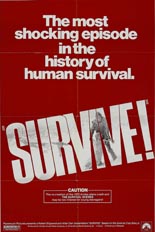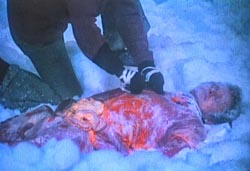
 In 1972, a charter jet carrying a rugby team from Uruguay to Chile crashed in the snowy Andes mountain range. In 1972, a Uruguayan ruby team chartered a plane to take its players to Chile, only to crash-land in the Andes Mountains.
In 1972, a charter jet carrying a rugby team from Uruguay to Chile crashed in the snowy Andes mountain range. In 1972, a Uruguayan ruby team chartered a plane to take its players to Chile, only to crash-land in the Andes Mountains.
I share this information with you twice because right off the bat, Survive! — exclamation point theirs — does the same; as the camera pans over the faces of 40-some-odd passengers (to whom you should not get attached), the narrator relays information already delivered by an introductory title card mere moments before. This is just one way the film from Mexico’s Rene Cardona Sr. (Night of the Bloody Apes) presents itself as a sloppy, slapdash production — at least in the U.S. version, oddly shepherded by the flamboyant Allan Carr of Grease fame and Can’t Stop the Music infamy.
 Cognizant of the disaster-film craze of the era (which Cardona’s son took full advantage of in his own work), Survive! wastes little time getting to the goods: the wreck of the plane, thanks to a navigation miscalculation. On a Cardona budget, the tragedy is illustrated with what looks like a toy model drifting into a mound of laundry detergent in powder form. Unspectacular the accident may be cinematically, the aftermath carries no such limitations, as witnessed by a survivor’s attempt to the stuff a goopy loop of intestines back in a fellow passenger’s gut.
Cognizant of the disaster-film craze of the era (which Cardona’s son took full advantage of in his own work), Survive! wastes little time getting to the goods: the wreck of the plane, thanks to a navigation miscalculation. On a Cardona budget, the tragedy is illustrated with what looks like a toy model drifting into a mound of laundry detergent in powder form. Unspectacular the accident may be cinematically, the aftermath carries no such limitations, as witnessed by a survivor’s attempt to the stuff a goopy loop of intestines back in a fellow passenger’s gut.
As rapidly as Cardona gets to that aviation blooper, he holds back on the scenes on which the film was sold to theatergoers: those involving cannibalism. Amid freezing temps, their hope for rescue runs out as speedily as their rations pilfered from all the up-for-grabs luggage scattered about: wine, chocolate bars, fish tins, cheese and marmalade. The survivors eventually face the coldest and hardest of cold, hard facts: Eat human flesh or die. As history tells us, we know which option they select: They pick their unappetizers straight from the Donner Party menu.
Considering the name-brand source, I wish Survive! were more exploitative than it is. The picture possesses Señor Cardona’s regular hallmarks, from an unflinching eye for gore to his usual leading man in Nightmare City’s Hugo Stiglitz, yet after the initial plane-meets-mountain depiction, those elements disassemble and never quite come together again. Their failure to do so rests upon a glacial pace, as if we, the viewers, were having to trudge alongside the characters to get to the next shocking moment. In 1993, Arachnophobia director Frank Marshall told the same true-life tale with a bigger budget, with the punctuation-free Alive. —Rod Lott
